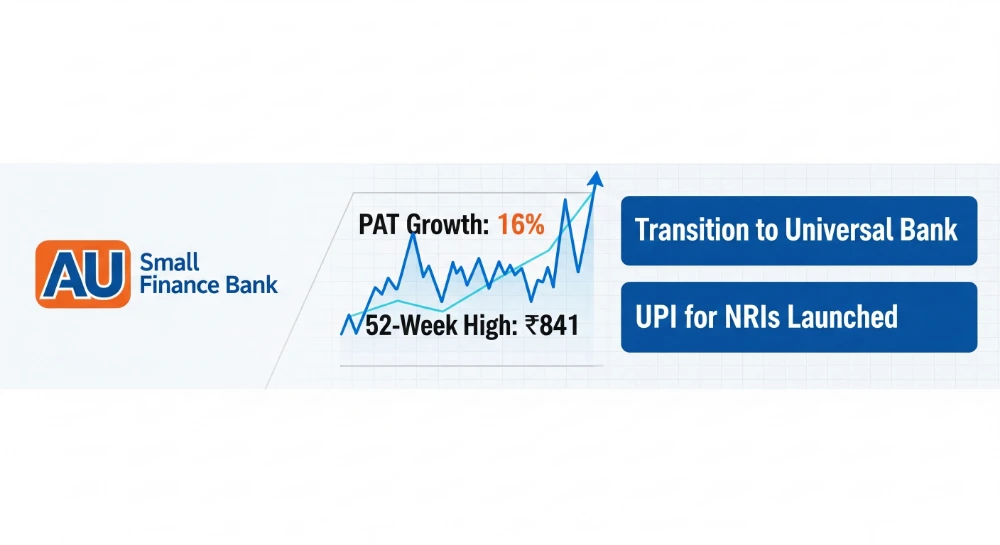AU Small Finance Bank Share Price: Recent Trends
The shares of AU Small Finance Bank have seen active movements in recent weeks. After maintaining stability for a considerable period, the stock recently experienced a short-term decline. This small correction reflects profit booking by investors and market adjustments to the latest quarterly earnings. Despite these fluctuations, the long-term outlook remains positive, supported by consistent performance, rising income levels, and strategic expansion moves.
For many retail and institutional investors, AU Small Finance Bank continues to remain a reliable stock in the small finance and mid-cap banking category, with an eye on future upgrades in valuation as it transitions into a larger banking institution.
2. Strong Q1 FY26 Performance: Profit Growth Amid Challenges
In the first quarter of the current financial year, AU Small Finance Bank reported a 16% year-on-year growth in net profit, reaching well above ₹500 crore. This growth came despite challenging market conditions and higher provisioning.
The bank’s total income for the quarter increased significantly, supported by robust lending activity and a strong deposit base. Its gross loan portfolio expanded by nearly 18%, showing healthy credit growth. However, the gross non-performing asset (NPA) ratio inched slightly higher compared to last year, signaling the impact of macroeconomic headwinds.
Even with this increase in NPAs, the bank managed to maintain a strong capital adequacy ratio of nearly 19%, showcasing a resilient balance sheet and a well-buffered capital position.
3. Universal Banking Licence: A Historic Milestone
One of the biggest highlights for AU Small Finance Bank is the recent approval it received to transition into a universal bank. This development marks a historic milestone, as no other small finance bank has been granted this status in the last decade.
The universal bank licence will allow AU to expand its scope of operations beyond traditional small finance banking. It can now diversify its product portfolio, reach new customer segments, and compete directly with larger private sector banks. For depositors and borrowers, the transition does not bring any immediate changes—account numbers, debit cards, credit cards, and cheque facilities remain the same.
However, over the long term, customers can expect broader services, more digital banking features, and better integration of retail and corporate banking products under the universal banking structure.
4. Restructuring Roadmap: NOFHC and Headquarters Shift
To align with regulatory norms for universal banks, AU Small Finance Bank’s promoter is required to transfer the entire equity stake into a Non-Operative Financial Holding Company (NOFHC). This restructuring will strengthen governance standards, provide more transparency in shareholding, and pave the way for long-term sustainability.
The bank has been given a window of more than a year to complete this transformation. Alongside, AU Small Finance Bank is also relocating its corporate headquarters from Jaipur to Mumbai, India’s financial hub. This move signifies the bank’s ambition to be at the center of the country’s financial ecosystem, closer to regulators, capital markets, and other large institutions.
5. Implications for Investors
For investors, these developments bring multiple implications.
| Factor | Impact |
|---|---|
| Profit Growth | Reinforces the bank’s fundamental strength and ability to deliver consistent results. |
| Universal Bank Licence | Opens up new growth opportunities, strengthens the brand, and provides diversification benefits. |
| NOFHC Structure | Ensures stronger compliance and better governance, boosting investor confidence. |
| Headquarters Shift | Positions the bank strategically for expansion and improved access to financial markets. |
Market analysts remain cautiously optimistic about the stock. Some recommend holding the stock for the long term, highlighting its growth potential post-transition, while others advise a selective approach in the short term due to restructuring requirements and rising provisioning.
6. Future Outlook: Building a Bigger Banking Identity
AU Small Finance Bank is at a turning point in its journey. From being a regional finance company to becoming a respected small finance bank, and now transitioning into a universal bank, the institution has consistently shown adaptability and vision.
The near-term focus will remain on successfully implementing the NOFHC structure, managing asset quality, and scaling up operations post headquarters relocation. At the same time, the bank is expected to expand its retail and MSME lending base while strengthening its presence in digital banking solutions.
For long-term investors, AU Small Finance Bank represents an opportunity to participate in the growth story of a rising financial institution that is moving into the league of full-scale universal banks. With strong fundamentals, regulatory approvals, and a clear expansion roadmap, the stock is poised to play an important role in the evolving Indian banking sector.
Final Thoughts
The journey of AU Small Finance Bank from a niche small finance player to a recognized universal bank reflects resilience, innovation, and ambition. Its consistent profit growth, strong deposit base, and strategic decisions such as shifting to Mumbai and adopting the NOFHC model underline its readiness for the next phase of growth.
While short-term fluctuations in share price are inevitable, the overall outlook remains promising. For investors and stakeholders, AU Small Finance Bank stands out as a growth-oriented institution with the potential to shape its identity as a major player in India’s fast-growing banking industry.





